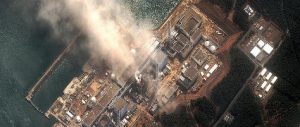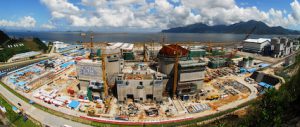During China’s parliamentary season this month, the government put out a number of signals that the moratorium on approving new nuclear-power plants may soon be lifted. Wen Jiabao’s government work report mentioned the “safe and efficient development of nuclear power”, while a host of heavyweight figures made speeches in support of the sector. The nuclear spring that Japan’s Fukushima crisis brought to an abrupt end in March last year now looks set to return.
China was quick to respond to the Fukushima catastrophe. Six days after the problems began, the government announced that it was suspending the approval process for new nuclear plants while it conducted a safety audit of nuclear facilities, created a new national nuclear-safety plan and made adjustments to mid- and long-term plans for the development of nuclear power.
But by the end of 2011, there was a sense among nuclear equipment manufacturers and power-plant developers that their sector might be about to make a comeback.
At the end of December, Harbin Power Equipment Company (HPEC), one of China’s largest suppliers of nuclear-power equipment, signed a deal with the China Nuclear Engineering Corporation (CNEC) and Jiangsu Nuclear Power Corporation (JNPC) to provide turbo generators for the number three and number four reactors at Tianwan Nuclear Power Plant in eastern China. This was the first turbo generator contract to be signed in the country since Fukushima. In March 2012, HPEC won a similar contract for the number three and number four reactors at Haiyang Nuclear Power Plant in Shandong province.
These reactor projects have been given the go-ahead to carry out site preparation work, but not to begin actual construction.
The nuclear industry is expecting the moratorium to be lifted this year, and the stock market is responding. Companies that saw their share prices jump in March include valve-maker Jiangsu Shentong, manufacturer of zirconium products (used in cladding and pipes) Orient Zirconic, Shanghai Automation Instrumentation, Dongfang Electric and Shanghai Electric.
Wang Binghua, chair of State Nuclear Power Technology Corporation (SNPTC), has made clear he expects the government to resume approvals during 2012. Li Yongjiang, vice-chair of the China Nuclear Energy Association, has gone further, saying he believes the change will come in the first half of the year.
Safety concerns were at the heart of China’s decision to effectively ban new nuclear plants. And, of the actions taken by China in the post-Fukushima period, it was the safety audit of its nuclear facilities that garnered most attention. Wang Binghua recently revealed that 14 points in need of rectification were identified during these checks. “Some have already been dealt with, some are being dealt with and some have been shut down and given a three-year programme of improvements,” he said.
In the second half of 2011, in a move also aimed at improving the resilience of China’s nuclear reactors, the National Energy Administration launched a research and development programme focused on 13 specific nuclear-safety issues. China National Nuclear Corporation (CNNC), China Guangdong Nuclear Power Group (CGNPC) and Tsinghua University are all involved in the programme.
Meanwhile, the national nuclear-safety plan, seen as key to restarting approvals of new plants, was given the nod by the Ministry of Environmental Protection at the end of 2011 and passed to the State Council, China’s highest administrative organ. And, according to Li Yongjiang, the State Council held a meeting to finalise that plan in February.
The new nuclear safety plan is understood to require higher safety standards for nuclear facilities and technology, and to significantly lower the level of radiation risk deemed acceptable.
Revisions to China’s plans for the mid- and long-term development of nuclear power are also being closely watched by the industry. A blueprint released five years ago included a target for 40 gigawatts of operational nuclear-power generating capacity by 2020. However, ambitions appear to have grown significantly since then. A report on implementation of the 12th Five-Year Plan published by the China Electricity Council on March 14 estimated that China’s nuclear-generating capacity would reach 80 gigawatts by 2020.
Li Ning, associate director at UCLA’s Berkeley Nuclear Research Centre, said: “It is very likely that the target for 2020 will be somewhere between 70 gigawatts and 90 gigawatts.”
The new nuclear safety plan – a prerequisite for lifting the moratorium – is yet to receive final approval. But the expectation that it will require “the most advanced technology and the strictest safety standards” has already led nuclear power firms to get busy upgrading their reactors from second-generation to third-generation designs.
Over the last year, explained Li Ning, CNNC and CGNPC – the two grandfathers of China’s nuclear sector – have focused on second- to third-generation technological upgrades. CNNC is working on designs for its third-generation ACP600 reactor, while CGNPC launched its ACPR1000 technology in November last year.
Meanwhile, construction of the many Chinese nuclear plants to have won approval before the moratorium was imposed has pressed quietly on. Even in 2011, a bad year for nuclear power in China, new reactors went into operation at the Ling’Ao and Taishan nuclear plants. And China still has 26 reactors under construction, more than any other country.
Zhong Yingqing, director of the Party and Masses Work Department at CNNC’s Sanmen Nuclear Power Company, said that work never stopped at the Sanmen number one reactor site, a third-generation reactor. Construction is expected to complete this year, after which system testing will begin.
The four reactors using AP1000 technology – the design owned by Japanese-owned engineering company Westinghouse – were also unaffected by last year’s policy change.
One industry insider, who wished to remain anonymous, said that, when approvals restart, there will be a marked preference for third-generation technology. “There is a possibility that in future only third-generation AP1000 reactors will receive permission, apart from a pilot high-temperature, gas-cooled reactor and the second phase of the Tianwan facility,” he said.
Supporters of third-generation AP1000 technology say this reactor not only performs well on the two key safety issues – the likelihood of a rector meltdown and the likelihood of a large-scale release of radiation – but its emergency systems also represent a major step forward: human input is not required for the first 72 hours after an accident. The stricken Fukushima reactor gave site workers a 30 minute window to react to the problem.
China has 15 operating reactors, all of which are so-called “2+” technologies, meaning improved versions of second-generation reactors. Twenty-six further reactors have been approved and are under construction, but only six of these are third generation. The rest are all “2+”. The industry source we spoke to also revealed that, among the projects that have already won approval, 14 (more than 67%) could be upgraded to third–generation designs.
However, Liu Wei, chief executive of China Nuclear Power Engineering, said that the differences between the generations are often overstated. “There are usually commercial reasons for playing up the idea of different generations of technology,” he said. In fact, the passive safety systems of the “third generation” reactor fast becoming the backbone of China’s nuclear future – the AP1000 design – have themselves been widely questioned in the past, including by the US Nuclear Regulatory Commission.
Plans for nuclear plants in China’s interior are also under scrutiny. While the country’s nuclear programme has tended to focus on coastal provinces, in the period before the Fukushima disaster many inland provinces also put forward proposals for nuclear construction, including Hubei, Hunan, Jiangxi, Anhui, Henan, Chongqing, Sichuan and Jilin. During the March parliamentary sessions in Beijing, Wang Bingfa indicated that design standards for inland reactors would be identical to those used for coastal facilities, but that emissions standards would be higher.
But that does not explain how to make inland reactors safer, or how to ensure provision of water for cooling. Li Yongjiang suggested that “construction of nuclear power plants in economically-laggard and water-poor areas should be slowed down.”
It normally takes around five years to build a nuclear power plant in China. If the government goes with the target of 80 gigawatts of capacity by 2020, then the industry will hope to build an average of eight one-gigawatt reactors every year.
However, given current progress on the plans and expectations that a cautious approach will initially be adopted after the moratorium ends, Liu Wei believes there is little chance of a large-scale building programme getting under way this year: “It’s likely five or six plants will be approved initially,” he said. “The bigger surge in nuclear power plant building will come between 2015 and 2020.”
Feng Jie is a reporter at Southern Weekend, where this article was first published.
This article is published here as part of Nuclear Enery and Developement Programme, which is supported by the Heinrich-Boell Foundation.
Homepage image by Craig Hanson shows a nuclear reactor in Lianyungang, China.



